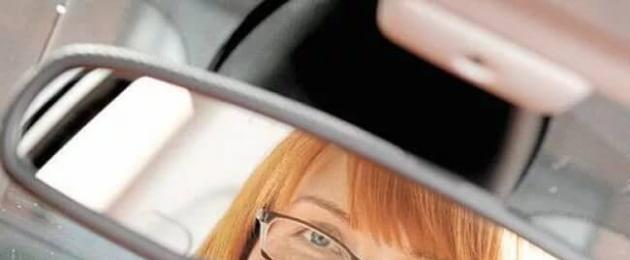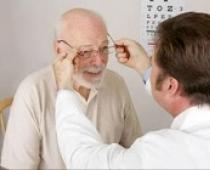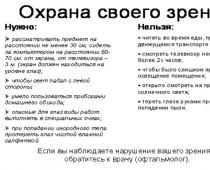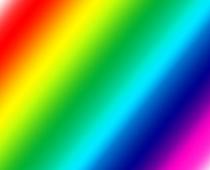There are certain reasons for which the oculist is obliged to refuse to issue a certificate for obtaining a driver's license.
If the potential driver’s vision is lower than the established norms, the certificate may be refused. As a rule, in people with poor eyesight, one eye sees better than the other, therefore for category B, the norm of sharpness is better than seeing the eye not lower than 0.6 and worse than seeing the eye not lower than 0.2, for category C not lower than 0.8 and 0.4 respectively.
If the vision does not meet the standards, driving with glasses or lenses is possible, but there is a limit of up to ± 8 diopters and a difference of no more than three diopters between the right and left eye. Otherwise, help will not be given.
The test for color perception (using special tables) is necessary when determining the colors of a traffic light, since not distinguishing colors can lead to dire consequences. Since this anomaly is not corrected with the help of glasses and contact lenses, this is a serious barrier to obtaining a driver's license. There is an exception - if a person already has driving experience and has a mild degree of color blindness, he may reapply.
In some eye diseases, a narrowing of the visual field is observed. For categories B and C, this indicator cannot be lower than 20 degrees. For categories D and E, the narrowing of the angle of view is unacceptable. Since this pathology can not be corrected with the help of glasses and contact lenses, driving is prohibited.
If there are quite dangerous eye diseases, such as cataracts, glaucoma, and others, it is impossible to obtain medical permission.
What vision is allowed to get behind the wheel?
If a person has excellent vision and there are no other contraindications, according to the legislation of Russia, he has every right to drive a vehicle. But if a person suffers from myopia, this is not a reason for depriving him of driving a car. In this case, the vision can be corrected with the help of glasses or contact lenses. If there are more serious pathologies of vision, even in this case, the person can be allowed to drive, subject to successful operational correction.
There are cases of dishonest passage of the medical board. Such a driver is a dangerous participant in traffic, because fuzzy vision, a narrow viewing angle, poor color perception prevent complete control of the situation on the road.
Today, everyone has the opportunity to learn to drive a car at a driving school. However, before you do this, it is useful to pass the medical commission. After all, it is on the basis of her verdict that the possibility of admitting the person willing to learn will be determined. At the same time, it is worth remembering that the special attention of the medical board is riveted to the candidate’s vision, since the visibility of the road depends on his condition, and most importantly, the driver’s reaction to any situations. So what should be the vision to get a driver's license became a happy reality?
Visit to the ophthalmologist
To skip the office of this doctor during the passage of the medical commission will not work with all the desire. Well, if there are no problems with vision. Then wearing the additional correction in the form of glasses or contact lenses when driving is not required. Otherwise, they can not do without. In any case, the final conclusion will be made by an ophthalmologist, after conducting a thorough comprehensive diagnosis of visual functions.
Definition of visual acuity
The specialist will check this indicator first. The check will consist in reading optotypes (certain characters) of a special table from a distance of 5 meters. First, a study of one eye, then the second. In the case when a person manages to read 10 lines without problems, 100% of his eyesight is diagnosed - everything is in order. If the tenth line cannot be read, visual acuity is determined by further reading 9.8, 7, and so on.
It should be borne in mind that driving a car with visual impairment, is possible only with glasses or contact lenses. Therefore, if a person already has a means of correction, the study is conducted with their use. Thus, the ophthalmologist will determine the visual acuity and its compliance with the possible for obtaining a driver's license and driving a car.
Very often, potential drivers are interested in the question of whether it is possible to get right if the eyes are chameleons? It should immediately reassure all concerned about this problem: the color of the eyes can not affect visual acuity, and hence the possibility of obtaining a driver's license.
Minimum performance for driving
The next thing worth remembering for those who want to study in a driving school is the minimum acceptable visual acuity indicators:
- For drivers of category "B", it is 0.6 units for a better seeing eye and 0.2 units for a worse seeing eye;
- For drivers of category “C”, a better seeing eye must have 0.8 or more units (without using glasses and lenses), a worse seeing eye is 0.4 units or more. Also a valid option is considered when the visual acuity on each eye is 0.7 units.
As mentioned above, driving in contact lenses and glasses is allowed. However, in this case there are some limitations. Namely, the optical power of any means of correction should not be greater than plus or minus 8 diopters. At the same time, the difference between the strength of the lenses or glasses of the glasses of both eyes should not be more than 3 diopters.
Color perception level
This is the name of another indicator that is necessarily taken into account when checking eyesight for obtaining rights. It will depend on him how well the driver can distinguish the colors of the traffic light. In order to determine the color perception of a person, as a rule, the Rabkin table is used. According to her, for obtaining rights a driver can have only a slight violation or an anomaly of type “A”. This violation does not create difficulties in distinguishing the colors of the traffic light. It is worth remembering that violations of color vision cannot be corrected with glasses or contact lensestherefore, if there is a serious anomaly, you will have to forget about driving a car.
line of sight
Narrow outlook is rarely seen among drivers, and usually indicates the possible presence of serious diseases of the organ of vision. In such a situation, the maximum allowable narrowing of the visual fields is taken into account - up to 20 degrees. Unfortunately, it is also impossible to fix him with lenses or glasses, so in the case of higher rates, a person is not allowed to learn.
Eye diseases
There are a number of eye diseases that may also be a contraindication for obtaining a driver's license. It is about, and. However, in this case, the final decision remains for the doctor, who must determine the severity of the disease, based on the results of the survey.
Thus, depending on the state of vision, driving is not always possible. Those who disagree with the doctors' verdict often go for some tricks (they memorize test charts, buy references), completely unaware that a driver who sees poorly is a danger on the road not only for themselves, but also for a huge number of people. around. That is why ophthalmologic examination The eye is a very important, obligatory step on the way to obtaining a driver's license, which can not be neglected.
It's no secret that you need to pass a medical examination to get a driver's license. The commission includes an ophthalmologist, whose main task is to examine the patient for eye diseases, some of which are contraindications to driving. Let us dwell in more detail on the problems of permissible vision for a driver's license.
Visual acuity
This is the most important indicator on which it depends whether you get the rights or not. Visual acuity is determined using Sivtsev's table, familiar to everyone from childhood, on which letters of different sizes are written. The sharpness is determined separately for each eye, first without glasses, and then with corrective glasses. So with what visual acuity can you not get access to driving?
Important! Even if you have low visual acuity, it does not mean that you will be left without rights.
Rights will not be granted in the following cases:
- When the difference in visual acuity of the eye is more than 0.4.
- When and hyperopia very high, when you want to wear glasses or lenses with optical power of more than 8.0 diopters.
- If you have, and the sum of the sphere and the cylinder (specific indicators of the optical power of the lenses) exceeds 8.0 diopters.
- With the blindness of one eye and the sharpness of the other below 0.8.
- When wearing glasses or lenses whose optical power differs by more than 3.0 diopters.
Impaired color perception
Distinguishing colors for the driver is very important - the correct perception of the color of the traffic light often prevents accidents. Someone may argue that it is enough to know the location of the colors at the traffic lights in order to drive according to the rules. However, there are not quite standard traffic lights and traffic lights with fewer sections! Therefore, before the exam on the rights do not allow people with color blindness. Color perception is checked using Rabkin tables.
Eye disease in which driving is contraindicated
There are diseases in which the decrease in visual acuity is not so pronounced, and there is a normal color perception, but the doctor will not sign a certificate for admission to the driving test. What is this pathology and why it is impossible to drive a car with it?
- retinal disinsertion;
You cannot drive a car with these diseases, because their visual impairment cannot be corrected with glasses and lenses. Only surgery can restore vision in these diseases. But after the operation, not one doctor, but a whole council will decide on the issue of admission to driving.
Many people with poor eyesight go to various tricks in order to get rights - memorize the tables of Sivtsev and Rabkin or simply buy a certificate. At the same time, they do not understand at all that driving a car with poor eyesight creates a danger for the driver himself and those around him. In addition, most of these conditions, which are a contraindication to driving, are currently treatable. Therefore, do not risk your own and someone else's health, trying to deceive the medical examination!
Now the car is no longer considered luxury goods, but is a means of transportation. But even buying a private car or getting it as a gift, you can not get behind the wheel without getting a driver's license. Everyone knows that in order to obtain driving rights, it is important not only to practice and study theory, but also to pass a medical examination. One of the doctors who will need to visit will be an ophthalmologist who will check your eyesight. If you have any vision problems or eye diseases, this will be a contraindication for issuing a permit. What are the limitations on vision for obtaining a driver's license?
With the passage of the medical commission is a mandatory item is the permission of the ophthalmologist. This document is considered to be the most important, because road safety depends on the driver’s vision. In this regard, doctors are very careful about the question of passing an eye examination for obtaining a driver's license.
Having visited the oculist, examination of the organs of vision begins in the following areas:
- checking visual acuity (how well a person sees);
- determination of the color sensation level (detection of anomalies of eye functions);
- study of the outlook (how fully a person sees in his field of vision);
- eye diseases (if any).
Note! Even if there are some deviations, it does not mean that it is forbidden to drive vehicles.
With low vision, the doctor can pick up glasses or lenses. If any eye ailments are revealed, he will advise how to cure them.
In situations where the eyes are often tired, the ophthalmologist may prescribe special exercises for the eyes, which, after a long and constant period of time, can improve vision.
Important! If the future motorist is already wearing glasses or long-wearing optics, then these products must be brought to the specialist with you.
What should be visual acuity?
Visual acuity is considered to be a very important indicator in the examination, and it is mainly on it that it depends on whether you are issued with a vision permit for a driver's license.
Such an indicator is determined by the familiar Sivtsev table from childhood, which shows letters from large to small. Sharpness is checked separately for each eye. At first they do it without glasses, and then, if they exist, they are also determined in them.
The vision is considered ideal when a person could read 10 lines of the table below. If this does not work out, it is suggested to read the 9 or 8 line from the bottom (according to the situation).
So at what indicators there is a limit on vision for obtaining rights?
Driving license will not be granted in the following situations: 
- If the difference in the sharpness of two eyes is more than 0, 4.
- With myopia and hyperopia increased, when you need to wear glasses or lenses with diopters more than 8.0.
- In the presence of astigmatism, and the sum of the sphere and the cylinder is more than 8.0 diopters.
- If one eye is blind and the second is less than 0.8.
- When using glasses or lenses, which, as a rule, optical power has differences of more than 3 diopters.
Color perception and outlook
Obligatory stage is considered and check of the future motorist on color sensations, that is on perception of color scale of light. With the passage of the medical commission, doctors determine the ability of a person to distinguish the colors of traffic lights, which is very important for driving on the roads at the wheel. For such an examination, the Rabkin table is used.
Ophthalmologists distinguish three types of people according to color perception:
- Trichromates (have a norm).
- Protoanopes (there are deviations in the red spectrum).
- Deuteranopes (have a violation in the green spectrum).
If an indicator such as color perception has a deviation from the norm, then this state can not be corrected with the help of glasses or lenses, and also cannot be cured. And, of course, such violations are a restriction on vision for obtaining a driver's license.
Also, admission will not be allowed if the person has a narrow outlook. It is determined in the diagnosis of limiting vision narrowing. Its rate should not be more than 20º.
As with color blindness, a violation of the visual field is not corrected in any way and is not treated. Such a condition occurs very rarely and, as a rule, indicates the presence of very serious eye diseases.
Ailments eye-bans on driving
If the visual acuity is reduced by a small number, and the color sensation is normal, but the motorist has eye diseases, the doctor will not allow to attend driving courses. These eye diseases include:
- retinal disinsertion;
- cataract;
- pathological disorders of the lacrimal sac;
- glaucoma.

In the presence of the above listed diseases, even a valid vision for a driver's license will not help in obtaining a certificate of permission. This is due to the fact that such eye ailments are not treated by a conservative way and the selection of the correct optics. Their therapy can only be effective after surgery. Only after such a method of treatment, after a certain time, namely, not earlier than 3 months, not one specialist will decide on the admission to driving a car, but several.
- In contact with 0
- Google+ 0
- OK 0
- Facebook 0








